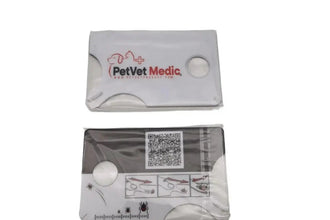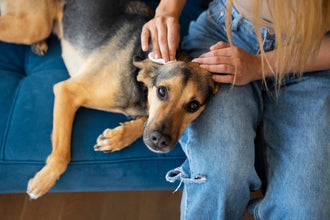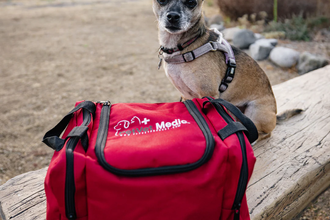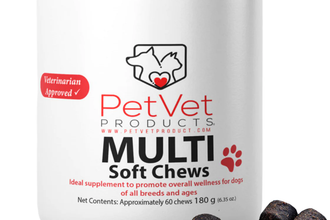
At Pet Vet Products, we understand that your pet is a beloved family member. When an emergency happens, knowing how to provide immediate care can make a significant difference in their recovery. Whether it's a minor injury or a more serious case requiring injured dog treatment, having the right supplies is essential.
With over 25 years of experience in veterinary care, Dr. Leah Hill and our dedicated team offer high-quality first aid kits and emergency products to help you handle unexpected situations with confidence.
Recognizing an Injured Dog and Taking Immediate Action

Dogs can get hurt in various ways, from minor scrapes to more serious injuries. Recognizing the signs of distress early can prevent complications. If your dog is limping, bleeding, or showing signs of pain, it’s essential to act quickly. A dog first aid kit should always be on hand to address minor injuries before seeking veterinary care.
Cleaning and Dressing Wounds
For minor cuts and scrapes, proper wound care is essential.
-
Clean the wound gently using warm water and a pet-safe antiseptic solution. Avoid using hydrogen peroxide, as it can slow healing.
-
Dry the area carefully and apply an antibiotic ointment.
-
Cover the wound with a clean bandage to protect it from dirt and bacteria.
-
Change the bandage at least 1–3 times daily to prevent infection.
-
Use an Elizabethan collar to prevent your dog from licking or scratching the wound.
Understanding Your Dog’s Vital Signs
Knowing your dog’s normal vital signs helps determine if they need urgent care. If your dog seems unwell, check the following:
-
Temperature: Normal range is 101°F–102.5°F.
-
Heart Rate: A healthy range is 70–160 beats per minute.
-
Breathing Rate: Normal respiration is 10–30 breaths per minute.
If any of these are outside the normal range, it may be a sign of a medical emergency requiring immediate veterinary attention.
Common Canine Emergencies and First Aid Steps
Stopping Bleeding
If your dog is bleeding, stay calm and act quickly:
-
Apply gentle but firm pressure with a clean cloth or sterile gauze.
-
Keep the pressure steady for at least five minutes until the bleeding slows.
-
If bleeding is severe, wrap the wound and transport your dog to a vet immediately.
Treating Vomiting and Digestive Issues
Vomiting can be caused by various issues, from dietary indiscretion to poisoning. If your dog vomits once but seems fine, monitor them closely. However, seek veterinary care if:
-
Vomiting persists for more than 24 hours.
-
There is blood in the vomit.
-
Your dog is lethargic or showing signs of dehydration.
Managing Heatstroke
Heatstroke is dangerous and requires immediate action:
-
Move your dog to a cool, shaded area.
-
Offer small sips of water from a water bottle for dogs, but don’t force them to drink.

-
Use a cool, damp cloth on their paws, belly, and ears to lower their temperature.
-
Avoid ice-cold water, as it can cause shock.
-
Get them to a vet as soon as possible.
Handling Bee or Wasp Stings
A sting can cause swelling and discomfort. If your dog is stung:
-
Remove the stinger if visible using tweezers.
-
Apply a cold compress to reduce swelling.
-
Give antihistamines (only with veterinary guidance).
-
Seek immediate veterinary care if your dog has difficulty breathing or swelling spreads.
What to Do If Your Dog Is Choking?
If your dog is choking:
-
Look inside their mouth and try to remove any visible obstruction carefully.
-
If you can’t remove it, perform the Heimlich maneuver:
-
For small dogs: Hold them upside down and apply gentle pressure below the ribcage.
-
For large dogs: Place your hands just behind the ribcage and push firmly upward.
-
Take your dog to a vet immediately if choking continues.
Responding to Unconsciousness
If your dog collapses or becomes unresponsive:
-
Check for breathing and a heartbeat.
-
If there’s no breathing, perform CPR by giving gentle chest compressions.
-
Keep them warm and rush them to a vet.
The Importance of a Dog First Aid Kit
A well-stocked dog first aid kit is essential for handling emergencies at home or while traveling. It should include:
-
Gauze pads and bandages – For covering wounds and controlling bleeding.
-
Antiseptic wipes or solution – To clean cuts and prevent infection.
-
Tweezers – Helpful for removing splinters or stingers.
-
Digital thermometer – To check your dog’s temperature.
-
Elizabethan collar (cone) – Stops your dog from licking or biting wounds.
-
Hydrogen peroxide (3%) – Only use if advised by a vet for inducing vomiting.
-
A water bottle for dogs – Hydration is crucial, especially in heatstroke cases.
-
A dog first aid handbook – Quick reference for emergencies.
Having a first aid kit ensures you’re prepared for unexpected situations and can provide immediate care before reaching the vet.
Keeping Your Dog Comfortable During Recovery
After an injury, dogs need time to heal. Provide a calm and stress-free environment for recovery.
-
Keep their movement limited if they have a wound or sprain.
-
Prevent excessive licking with an Elizabethan collar.
-
Reward their patience with gentle attention or their favorite treats.
When to Call the Vet
While minor issues can be handled at home, some situations need professional care:
-
Heavy Bleeding That Won’t Stop
If your dog is bleeding heavily, act quickly to prevent excessive blood loss. Apply firm pressure using a clean cloth or sterile gauze and hold it for at least five minutes.
Avoid lifting the cloth frequently, as this can disturb clotting and worsen the bleeding. If the bleeding doesn’t stop or is severe, seek veterinary care immediately.
-
Broken Bones or Severe Limping
A dog with a broken bone or severe limp may be in extreme pain and distress. Avoid moving the injured limb and do not attempt to set the bone yourself.
Keep your dog as still as possible and transport it carefully to the vet. Improper handling can worsen the injury and lead to complications.
-
Seizures or Loss of Consciousness
Seizures can be alarming, but do not attempt to restrain your dog during an episode. Keep the area around them clear to prevent injury and time the seizure’s duration.
If the seizure lasts more than five minutes or occurs multiple times, seek urgent veterinary attention. Loss of consciousness is equally serious and requires immediate care.
-
Difficulty Breathing
Labored breathing, gasping, or wheezing can indicate a serious medical emergency. Causes may include allergic reactions, choking, or lung infections.
If your dog is struggling to breathe, keep it calm and transport it to the vet right away. Avoid forcing anything into their mouth unless you see an obstruction you can safely remove.
-
Suspected Poisoning
Dogs may accidentally consume toxic substances such as household chemicals, human medications, or certain foods. Symptoms of poisoning include vomiting, drooling, tremors, or difficulty breathing.
Do not induce vomiting unless advised by a vet, as some toxins can cause more harm if regurgitated. Contact a veterinarian or pet poison hotline immediately for guidance.
When in doubt, it’s always better to be safe and call your vet.
At Last
Knowing how to handle a pet emergency can make all the difference in your dog’s recovery. By keeping a dog first aid kit ready and understanding basic first aid techniques, you can act quickly in critical moments. Injured dog treatment should always include seeking veterinary care when needed and treating your furry friend with kindness and patience.
At Pet Vet Products, we provide high-quality first aid supplies and expert guidance to keep your pet safe. Explore our range of dog first aid kits, handbooks, and emergency essentials to ensure you’re prepared for any situation. Because when it comes to your pet’s health, being ready is the best care you can give.










